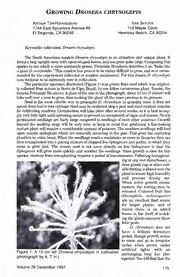Table Of ContentGrowing Drosera chrysolepis
Arthur Ter-Hovanessian Ivan Snyder
1744 East Sycamore Avenue #6 110 Meyer Court
El Segundo, CA 90245 Hermosa Beach, CA 90254
Keywords: cultivation: Drosera chrysolepis.
The South American sundew Drosera chrysolepis is an attractive and unique plant. It
forms a long upright stem with spear-shaped leaves, and can grow quite large. Comparing this
species to one which is more commonly grown, Fernando Rivadavia describes it as, ‘looks like
a giant D. scorpioides.” This sundew has proven to be rather difficult to grow, and so is recom¬
mended for the experienced cultivator or sundew connoisseur. For this reason D. chrysolepis
may continue to be extremely rare in cultivation.
The particular specimen illustrated (Figure 1) was grown from seed which was original¬
ly collected from nature in Serra do Cipo, Brazil, by our fellow carnivorous plant fanatic, the
famous Fernando Rivadavia. A plant of the size in the photograph, about 13 cm (5 inches) will
take well over a year to grow, thus making the plant all the more precious to its growers.
Seed is the most reliable way to propagate D. chrysolepis in quantity, since it does not
sprout from leaf or root cuttings. Seed may be scattered atop a peat and sand mixture suitable
for cultivating sundews. Germination will take place after several weeks, so it is best to sup¬
ply very little light until sprouting occurs to prevent an overgrowth of algae and mosses. Newly
germinated seedlings are fairly large compared to seedlings of most other sundews. Growth
beyond the seedling stage will be very slow, so keep in mind that producing a fine-looking
mature plant will require a considerable amount of patience. The newborn seedlings will feed
upon minute springtails which are naturally occurring in the pots. This gives the capturing
plantlets an extra boost. When the seedlings reach a centimeter or more in diameter they are
then transplanted into a potting mixture of chopped live Sphagnum and perlite, in which they
seem to grow best. The reason seed is not sown directly on live Sphagnum is that the
Sphagnum will grow more quickly and smother the seedlings. Since growth is slow for this
species, recovery from transplanting requires a period of convalescence. Following transplant¬
ing or any root disturbance, a
clear plastic cup or other suit¬
able tenting is placed over the
plant to insure high humidity
and prevent drying out.
When active growth recom¬
mences, the tenting may be
removed. Cultured fruit flies
(Drosophila melanogaster)
are an excellent food source
for larger plants, and of
course there is an added
bonus in the thrill of watch¬
ing the plants consume these
little pests.
D. chrysolepis does not
have a definite dormancy
period, though growth seems
to come and go in irregular
cycles when grown under
artificial lights with an
Figure 1: A 13 cm tall Drosera chrysolepis in cultivation
unchanging long day pho¬
(photograph by A. T. H.)
toperiod. You will find that the
Volume 26 December 1997 115
plant is a very shy flowerer when grown under artificial conditions. So if you are thinking of
trying to get your plant to produce seed, you must experiment. We wish you luck, since we have
yet to see it flower.
There is still another method of reproduction, albeit slow, which you can use to reproduce
your plant. As your D. chrysolepis grows to an extreme height, you may wish to reduce it again,
as there is a maximum optimal height. This may be done by simply cutting the stem and
replanting the top. New roots are produced near to the meristem or growth point, so cut the
stem about five cm below, strip off most of the lower leaves and plant vertically so that the
growth tip is just above ground. Now tent it as described earlier. Plant the lower portion of the
stem, retaining a few leaves, as this may sprout a new growth point and form another plant.
D. chrysolepis replanted in this manner makes the plant’s growth immortal.
I CARNIVOROUS PLANTS I
Venus Flytrap, Pitcher Plants, Sundews, Butterwort
3” Finished Plants, Pre Packaged and Ready for Retail
Plug Trays for Growing on
Tissue Cultured Tubs
Booman Floral... The Largest Wholesale Selection of Carnivorous Plants.
(760) 630-4170 / fax (760) 630-4173
Triffid Park
Email, Fax or write for our wholesale, retail and tissue culture lists of
carnivorous plants. Specializing in export.
Triffid Park
257 Perry Road
Keysborough 3173
Vic. AUSTRALIA
Phone/fax: (61 3)9769 1663
Email: [email protected]
www: http://www.dingley.starway.net.au/~triffid
^ For the Luorld’s largest selection of ^
carniuorous plants and seed
Send a stamped, self addressed business sized enueiope
(Australia) or 3 international reply paid coupons
(ouerseas) for catalogue, to:-
A. Louirie
6 Glenn Place, Duncraig, 6023, Western Australia
116 Carnivorous Plant Newsletter

